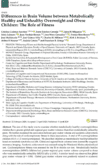Abstract
The aim of this study was to examine the role of fitness and whether metabolically healthy overweight/obese children have greater global and regional grey matter volumes than their metabolically unhealthy peers. We further examined the association between grey matter volume and academic achievement, along with the role of cardiorespiratory fitness in these associations. A total of 97 overweight/obese children (10.0 ± 1.2 years) participated. We classified children as metabolically healthy/unhealthy based on metabolic syndrome cut-offs. Global and regional brain volumes were assessed by magnetic resonance imaging. Academic achievement was assessed using the Woodcock-Muñoz standardised test. Cardiorespiratory fitness was assessed by the 20 m shuttle run test. Metabolically healthy overweight/obese (MHO) children had greater regional grey matter volume compared to those who were metabolically unhealthy (MUO) (all p ≤ 0.001). A similar trend was observed for global grey matter volume (p = 0.06). Global gray matter volume was positively related to academic achievement (β = 0.237, p = 0.036). However, all the associations were attenuated or disappeared after adjusting for cardiorespiratory fitness (p > 0.05). The findings of the present study support that metabolically healthy overweight/obese children have greater grey matter volume compared to those that are metabolically unhealthy, which is in turn related to better academic achievement. However, cardiorespiratory fitness seems to explain, at least partially, these findings.



Responses